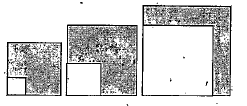
'In these figures, the sides. of the smaller squares are in the arithmetic sequence 2,5,8,.... and the sides of the larger squares are in the arithmetic sequence 5,8,11,....
a) Write down the algebraic form of each sequence.
b) Write down the algebraic form of. the sequence of areas of the shaded portion in each figure.Solution in Malayalam
Step by step video & image solution for 'In these figures, the sides. of the smaller squares are in the arithmetic sequence 2,5,8,.... and the sides of the larger squares are in the arithmetic sequence 5,8,11,.... a) Write down the algebraic form of each sequence. b) Write down the algebraic form of. the sequence of areas of the shaded portion in each figure. by Maths experts to help you in doubts & scoring excellent marks in Class 10 exams.
Updated on:21/07/2023Topper's Solved these Questions
Similar Questions
Suppose we draw circle with the bottom side of the. triangles in the picture as diameter. Find out whether the top comer of each triangle is inside the circle, on the circle. or outside the circle.
'(##VPU_TTT_MAT_X_P01_C02_E01_001_Q01##)'
View SolutionThe area of the shaded part in the figure given below is ______.

View SolutionWhich inequations represent the shaded region in the given figure
View SolutionWhat is the distance OA for the square shown in figure :- ltimg src="https://d10lpgp6xz60nq.cloudfront.net/physics_images/ALN_PHY_R05_E01_015_Q01.png" width="80%"gt
View SolutionProve that the arithmetic sequence 5,8,11,…... contains no perfect squares.
View SolutionSum of the algebraic form of an arithmetic sequence is 4n2+5n. Write the sequence.
View SolutionConsider 'the arithmetic sequence 10,17,24,…. i) What is its algebraic form? ii) Prove that there is no perfect square in this sequence.
View Solution23,30,37,.... is an arithmetic sequence a) Write the algebraic form of the sequence. b) Write the algebraic form of the sum of n terms of the sequence. c) Prove that the square of any term of this sequence will not be a term in this sequence. d) Prove that there will be so many, perfect squares in this sequence.
View SolutionConsider the arithmetic sequence 6,11 ,16,21,…..
a) Find the common difference.
b) Write the algebraic form of the sequence.
View SolutionConsider, the arithmetic sequence 2x+1,4x-1,5 x+1,….
a) Find x.
b) Write the algebraic form of the sequence.
c) Find the position of 195 in this sequence.
View SolutionAlgebraic form of an arithmetic sequence is 6n+3
a) Find the sum of first 20 terms of the sequence:
b) Write the algebraic expression of the sum.
View SolutionConsider the arithmetic sequence 17,20,23,26,….. a) Write the algebraic form of this sequence. b) Is 400 a term of this sequence?. c) Is the square of any term of this sequence belongs to this sequence? Why?
View SolutionWrite the algebraic form of 1,4,7,10,... Is 100 a term of this sequence. Why ? Prove that the square of any term of this sequence belongs to that sequence.
View SolutionThe algebraic form of an arithmetic sequence is 3+2n. What is the first form of the sequence?
View SolutionAlgebraic expressions of an arithmetic sequence is 5n+6. Write the sequence.
View SolutionWhat is the distance OA for the square shown in figure :- ltimg src="https://d10lpgp6xz60nq.cloudfront.net/physics_images/ALN_PHY_R05_E01_015_Q01.png" width="80%"gt
View Solution
